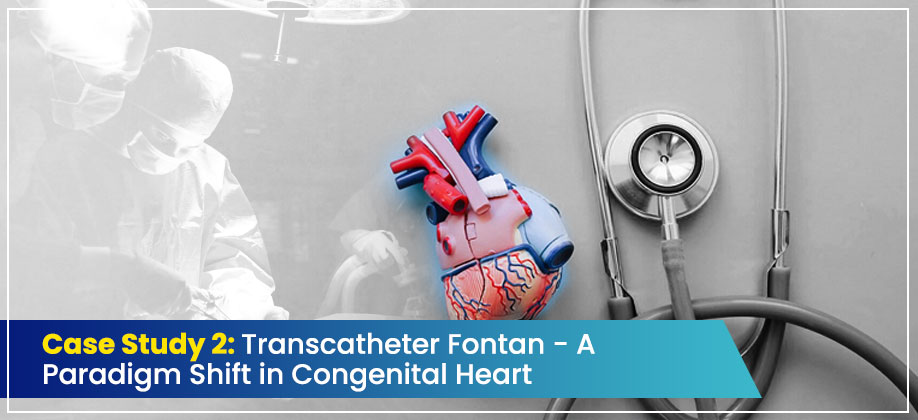This case study highlights the successful application of a transcatheter Fontan procedure, showcasing its advantages over traditional surgical methods and marking a significant advancement in the treatment of complex congenital heart defects. This represents the second such case performed at Narayana Health Hospital, Howrah.
Case Summary
A 10-year-old patient, diagnosed with Tricuspid Atresia, presented for definitive palliation. Pre-procedural assessments, including cardiac catheterization, confirmed good pulmonary artery (PA) anatomy and normal PA pressure and pulmonary vascular resistance index (PVRI), indicating optimal conditions for a Fontan procedure. The patient’s favorable hemodynamic profile made them an ideal candidate for the innovative transcatheter approach.
Diagnosis
The primary diagnosis was Tricuspid Atresia, a severe congenital heart defect characterized by the absence or malformation of the tricuspid valve, leading to a single functional ventricle. This condition necessitates a series of palliative surgeries, culminating in the Fontan procedure, to separate the systemic and pulmonary circulations.
Line of Treatment
The chosen line of treatment was a transcatheter Fontan procedure, performed entirely within the cardiac catheterization laboratory. This approach eliminates the need for open-heart surgery, offering numerous benefits. The intricate procedure involved several key steps:
- Perforation and Loop Creation: The procedure commenced with the precise perforation of the Right Pulmonary Artery (RPA) and Left Atrial (LA) roof using an Astato 40 CTO wire, employing heat coagulation at 50 Joules for controlled tissue ablation. This was followed by snaring the wire from the left atrium to establish an Inferior Vena Cava (IVC)-Right Internal Jugular Vein (RIJV) loop, creating a stable conduit for device delivery.
- Sheath and Catheter Placement: A 14 French long sheath was advanced from the IVC into the pulmonary artery. Careful positioning of a catheter into the Left Pulmonary Artery (LPA) and the most superior hepatic veins was maintained throughout the procedure to prevent jailing of these critical vessels during stent deployment.
- Stent Implantation and Dilation:
- The first covered stent, a Zephyr CS measuring 69mm, was meticulously placed using a 16/60mm MaxiLD balloon.
- Subsequently, a second covered stent, a Zephyr CS measuring 49mm, was positioned using a 20/60mm MaxiLD balloon.
- The lower end of the deployed stent was then post-dilated using a 25/40mm MaxiLD balloon to ensure optimal patency and flow.
- Flaring: Finally, both pulmonary arteries were crossed, and the upper end of the stent was flared to ensure a smooth transition and prevent obstruction.
Results
The outcomes of this transcatheter Fontan procedure were highly encouraging, demonstrating the significant advantages of this innovative technique:
- No re-do surgery: The procedure was definitive, avoiding the need for subsequent surgical interventions.
- No surgical preparation needed: The cath lab approach eliminated the extensive pre-operative preparations typically associated with open-heart surgery.
- No multiple chest drains: Patients experienced a less invasive recovery without the need for multiple post-operative chest tubes.
- Minimal inotropic requirement: The patient required very little inotropic support, indicating stable hemodynamics and a well-functioning Fontan circulation.
- Shorter procedure time: The transcatheter approach significantly reduced the overall procedure duration.
- Extubation within an hour: The patient was extubated remarkably quickly, within an hour of the procedure’s completion, signifying rapid recovery of respiratory function.
- Starts walking the following morning: Mobility was restored almost immediately, with the patient able to walk the morning after the procedure.
- Discharge in 4-5 days with 94% saturation: The patient had a remarkably short hospital stay, being discharged within 4-5 days, maintaining a healthy oxygen saturation of 94%.
This case underscores the transformative potential of transcatheter Fontan procedures, offering a less invasive, faster, and more comfortable recovery for patients with complex congenital heart disease. It truly ushers in a new era of cardiac intervention.


